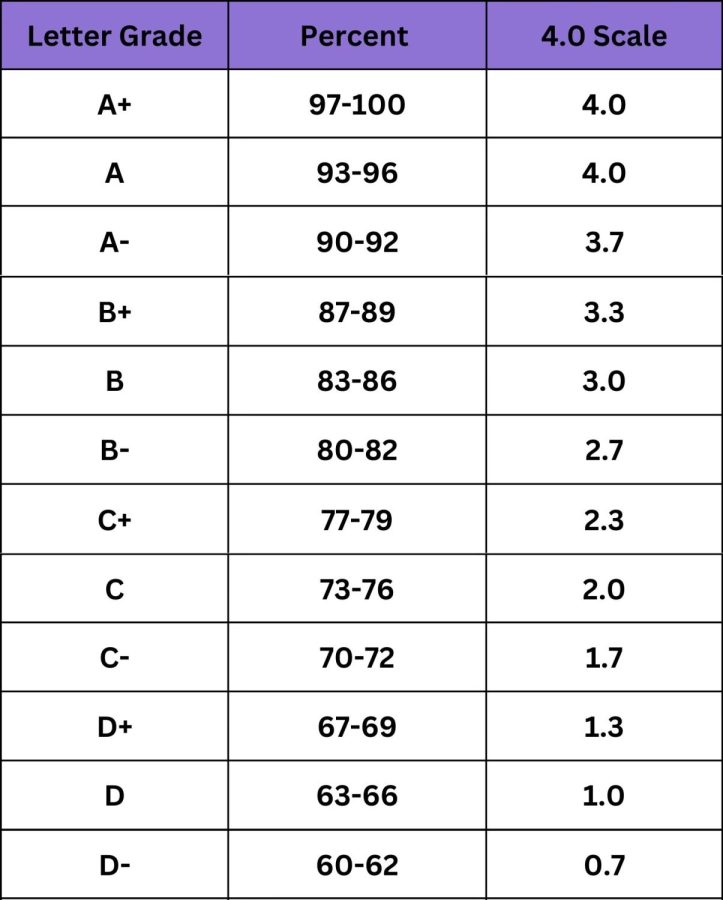“50% Rule” for assignments: dope or nope?
Most colleges and universities use the 4.0 scale where earning zeros will not hurt one’s grade nearly as much as the standard high school grading system
December 2, 2022
A student shakes their head in disbelief as they anxiously stare at the test in front of them, puzzled by the questions. Having mistakenly read the wrong chapter of a textbook, the student anticipates a total demolition of their grade. Lucky for them, the lowest grade they could receive is a 50%.
The MCPS Student Handbook states that teachers cannot give zeroes, and grades cannot be lower than a 50%. Altogether, any grades earned by a student that amount to 50% or lower must default to a 50%.
“I was present for the implementation in 2006,” WCHS economics teacher Monica Malanoski said. “There were and are a few teachers who support the 50% rule, there are also those who believe that it is not the correct policy across the board for all students.”
Students sincerely trying their best in their classes and benefiting from the policy is one story. But, students exploiting the rule to not submit assignments and still receive half-credit is very different in the minds of teachers.
“I believe the 50% rule should be applied to students who genuinely attempt an assignment, but zeros should be given to those that do not complete the assignments,” Malanoski said. “I feel that it is inequitable to give someone a 50% when they have not attempted to complete work.”
For many WCHS teachers, the expectation of giving half-credit to uninterested students who do not apply themselves to their work can be particularly frustrating.
“Some students have no motivation to do the work since they know that if they don’t do it they will still receive a 50%,” WCHS Spanish teacher Stacey Steele-Yue said. “If a student chooses not to make the work up, they should receive a zero, not a 50%.”
Many students view the policy as a crutch to depend on so that a few forgotten assignments will not plummet their grade. Despite this, many students do not realize that in the long-run, the policy could actually do more harm than good.
“This policy is not beneficial for WCHS students because it does not reflect what is happening at universities, nor in the workplace,” Malanoski said.
WCHS students who rely heavily on the no-zero policy may risk struggling with a tough transition from high school to college where grade inflation will not exist to an extent.
“I have had students come back to visit from college and they have told me that the grading system and having to take exams were a shock to them,” Steele-Yue said. “This does not mean they did not feel prepared for college but they had to learn how the system worked.”
At colleges and universities, the grading system is vastly different from MCPS. Incomplete and failed assignments are graded as 0%, and grades are based on the 4.0 scale.
“In the college grading system, a zero does not bring your grade down as much,” Steele said. “Which I think is one of the reasons high schools don’t want teachers to give zeros.”
A May 2022 report by American College Testing (ACT) found that average high school GPAs have increased by 0.19 grade points from a 3.17 in 2010 to a 3.36 in 2021. However, the national average composite ACT score has drastically declined, reaching its lowest in more than 30 years.
The correlation between these numbers does not add up. It is unlikely that the average national GPA can increase at the same time that standardized [ACT] test scores are at an all time low. The culprit is grade inflation policies exactly like MCPS’s 50% rule.“The 50% rule is not beneficial to students as it leads to them not being held accountable for their work. Churchill gives students more than enough time to make up work with the hard deadlines that have been imposed,” Steele said. “In the real world if you do not meet deadlines or only do 50% of the work there will be significant consequences to face.“



